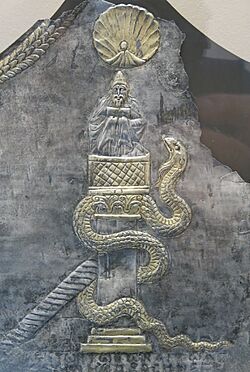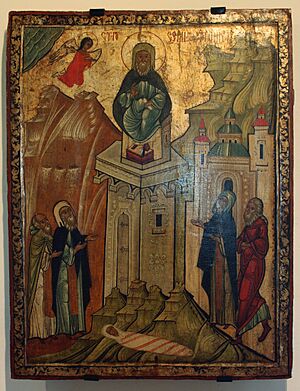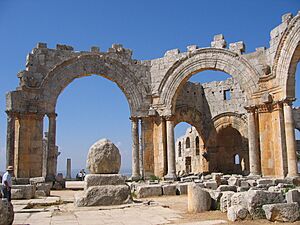Simeon Stylites facts for kids
Quick facts for kids SaintSimeon Stylites |
|
|---|---|

6th-century depiction of Simeon on his column. A scallop shell symbolizing spiritual purity blesses Simeon; the serpent represents demonic temptations (Louvre).
|
|
| Venerable Father | |
| Born | c. 390 Sis, Cilicia, Roman Empire |
| Died | 2 September 459 (aged 68–69) Qalaat Semaan, Byzantine Syria (between Aleppo and Antioch) |
| Venerated in | |
| Canonized | Pre-congregation |
| Feast |
|
| Attributes | Clothed as a monk in monastic habit, shown standing on top of his pillar |
Simeon Stylites (born around 390 AD – died 459 AD) was a Christian monk from Syria. He became famous for living on top of a tall pillar for 37 years! This unusual way of life was a form of asceticism, which means living a very strict and simple life, often giving up comforts, to focus on religious devotion.
The word "Stylites" comes from the Greek word style, meaning "pillar." Many other monks later copied Simeon's unique way of life. Simeon is honored as a saint in several Christian churches, including the Eastern Orthodox Church and the Roman Catholic Church. He is sometimes called Simeon Stylites the Elder to tell him apart from other saints with similar names.
Contents
Simeon's Life Story
His Early Years
Simeon was born in a place called Sis, which is now Kozan in modern-day Turkey. His father was a shepherd. This area was part of the Roman Empire at the time. After the Roman Empire split, this region became part of the Eastern Roman Empire. Christianity was very popular there.
When Simeon was about 13, he became very interested in Christianity. He joined a monastery before he was 16. In the monastery, he practiced a very strict way of life. He was so strict that the other monks felt he was too extreme for their community. So, they asked him to leave.
After leaving the monastery, Simeon lived alone in a small hut for about a year and a half. During this time, he reportedly spent the entire period of Lent without eating or drinking. When he came out, people saw this as a miracle. He then started standing upright for as long as he could.
Simeon later moved to a rocky area on a mountain. He tried to live in a small, quiet space. However, many people came to visit him. They wanted his advice and prayers. This left him with little time for his own religious practices. This led him to try a new way of life.
Living on a Pillar
To get away from the growing crowds, Simeon found an old pillar among some ruins. He built a small platform on top of it. He decided to live his life on this platform. Young boys from a nearby village would climb up to bring him flat bread and goat's milk. He might have also used a pulley system to get food.
When other experienced monks heard about Simeon's new and unusual way of life, they wanted to make sure he was doing it out of true humility, not pride. They told him to come down from the pillar. They planned to force him down if he refused, but if he obeyed, they would let him stay. Simeon showed complete obedience and humility. The monks then told him he could stay on his pillar.
Simeon's first pillar was only about 3 meters (10 feet) tall. Over time, he moved to taller pillars. The last one was reportedly more than 15 meters (50 feet) high! At the top of the pillar was a platform, believed to be about one square meter (about 11 square feet). It had a railing around it.
Even on his highest pillar, Simeon was not completely cut off from the world. In fact, the pillar attracted even more people. Both pilgrims and curious visitors came to see him. Simeon would talk with visitors every afternoon. People could climb a ladder to get close enough to speak with him. He wrote letters, taught his followers, and gave talks to the crowds below. He often spoke out against bad language and charging too much interest on loans. Even though his own life was very strict, his teachings were kind and sensible.
Simeon and other holy men in Syria played an important role in society. They helped settle arguments between farmers and in small towns. They were seen as fair and helpful leaders.
Fame and His Last Days
News of Simeon reached the church leaders and even the emperor. Emperor Theodosius II and his wife respected Simeon greatly and listened to his advice. Emperor Leo I also paid attention to a letter Simeon sent about an important church meeting. Simeon is also said to have exchanged letters with Genevieve of Paris, a famous saint.
The leader of the church in Antioch, Domninos II, even visited Simeon on his pillar and held a special church service there.
Once, when Simeon was sick, Emperor Theodosius sent three bishops to ask him to come down and let doctors help him. But Simeon chose to trust in God for his healing, and he soon got better.
A double wall was built around Simeon's pillar to keep the large crowds from getting too close and disturbing his prayers. Women were generally not allowed inside this wall, not even his own mother. He reportedly told her, "If we are worthy, we shall see one another in the life to come." She accepted this, stayed nearby, and became a nun, living a life of quiet prayer. When she died, Simeon asked for her coffin to be brought to him. He then respectfully said goodbye to his mother.
People disagree on exactly how long Simeon lived on the pillar, with estimates ranging from 35 to 42 years. He died on September 2, 459 AD. One of his followers found him bent over in prayer. The Patriarch of Antioch, Martyrius, led Simeon's funeral, which was attended by a huge crowd. Simeon was buried near his pillar.
Simeon's Lasting Impact

Simeon's unique way of life inspired many others. For the next hundred years, monks living on pillars, known as stylites, were a common sight across the Christian lands of the Middle East.
He is remembered as a saint in various Christian churches. His feast day is celebrated on different dates, such as September 1st in the Eastern Orthodox Church and January 5th in the Roman Catholic Church.
After his death, there was a friendly competition between the cities of Antioch and Constantinople over who would get Simeon's remains. Antioch was chosen, and most of his relics (holy remains) were kept there. People believed these relics would protect the city. Small tokens honoring Simeon Stylites have been found all over the Byzantine Empire, showing how popular he was.
The impressive ruins of a large church built in his honor, known in Arabic as the Qalaat Semaan ("the Fortress of Simeon"), can still be seen today. They are located about 30 kilometers (19 miles) northwest of Aleppo in Syria. The church complex has four basilicas (large church buildings) that spread out from an octagonal (eight-sided) courtyard, forming a large cross shape. In the middle of the courtyard is the base of the pillar where Simeon stood. In 2016, the pillar inside the church was reportedly hit by a missile.
See Also
- Desert Fathers
- Flagpole sitter
- Our Lady of the Pillar



